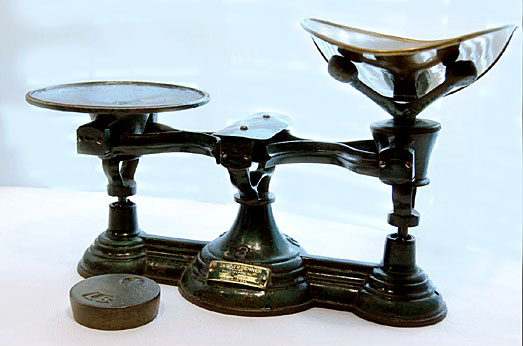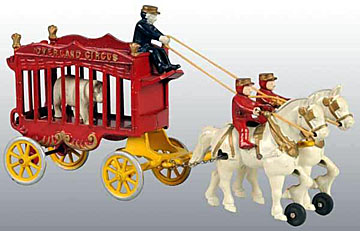 QUESTION: I have been fascinated with antiques enamel kitchenware since I was in my twenties. Over the years, I’ve purchased a number of pieces at flea markets and antique cooperatives. However, I bought them because I liked them. I know very little about this enamelware. When did it first appear? Why did manufacturers decide to make this type of cookware?
QUESTION: I have been fascinated with antiques enamel kitchenware since I was in my twenties. Over the years, I’ve purchased a number of pieces at flea markets and antique cooperatives. However, I bought them because I liked them. I know very little about this enamelware. When did it first appear? Why did manufacturers decide to make this type of cookware?
ANSWER: Today, we take pots and pans with non-stick surfaces for granted. With the invention of Teflon, the problem seemed to be solved. But people soon discovered that even Teflon had its drawbacks. Over time, many cooks discovered that enamel-lined cookware works even better than Teflon. But the use of enamel cookware isn’t new. In fact, it goes all the way back to Germany in the 1760s.
The original reason for the invention of enamel-lined cookware had nothing to do with its non-stick abilities. Back then, people wanted a a way of coating iron to stop the taste of metal or rust getting into their food. Cookware manufacturers looked for something acid-resistant and easy to clean without laborious scouring, something more durable than the tin linings used inside copper.
 Enamel was an expensive adornment material for jewelry and pottery from the ancient Egyptians to the Chinese and Anatolians and to the British.
Enamel was an expensive adornment material for jewelry and pottery from the ancient Egyptians to the Chinese and Anatolians and to the British.
Often called porcelain when used on cookware, enamel was a coating material in the form of powdered glass. Fired at very high heat in a kiln, this powdered glass melted, flowed and finally hardened on any surface that could withstand the process.
Craftspersons applied the fusing of the glass layer by layer, applying the design via a ceramic decal, permanently sealing it as a result of being fired at such high temperatures. The final result was a smooth and durable porcelain veneer decorated with artwork that would never peel.
 The use of vitreous enamel on cast iron sinks and bathtubs goes back to the 1850s and the Industrial Revolution.
The use of vitreous enamel on cast iron sinks and bathtubs goes back to the 1850s and the Industrial Revolution.
Craftspeople in the mid 19th century were already searching for a material that would enable a cooking surface that wouldn't rust and leach harmful substances into the food. By applying enamel to the inside of cast iron pots and pans, they created the first non-stick surface ideal for baking, cooking, and tableware to safely maintain the taste of their food.
From the late 19th century on, cookware manufacturers began to apply enamel to steel instead of cast iron. Enamel kitchenware stamped from thin sheets of steel appeared in every household as pans, pots, kettles, baking dishes, ladles, cups, bowls, plates, and biscuit cutters, becoming primary kitchenware.
This new cookware was not only easier to clean and scratch-proof but also lighter in weight. As an incredibly durable material, enamelware became popular because it was less fragile than china.
White was a standard color on enamelware since that gave plates, mugs, ladles, and coffee pots a bright, sanitary appearance. Cookware maker trimmed the rims of lightweight steel enamelware with a solid band of red or blue, while enameled cast iron, designed for the stovetop and oven, was usually white on the inside but colored on the exterior.
 Graniteware was a variation of lightweight enamelware that had a speckled surface—white on brownish-red and other colors. Patented in 1848 by New York inventor Charles Stumer, graniteware—also known as agateware and speckleware—enjoyed a long run in the United States, filling kitchen shelves and cabinets from the 1870s until the end of World War II.
Graniteware was a variation of lightweight enamelware that had a speckled surface—white on brownish-red and other colors. Patented in 1848 by New York inventor Charles Stumer, graniteware—also known as agateware and speckleware—enjoyed a long run in the United States, filling kitchen shelves and cabinets from the 1870s until the end of World War II.
U.S. manufacturers of graniteware included the St. Louis Stamping Company, which marketed its products under the Granite Iron Ware brand, Lalance and Grosjean, whose Peerless Gray Ware was sold by Sears, Roebuck and Company, the Bellaire Stamping Company, and Vollrath.

The 1870s witnessed an emergence of innovation in American kitchenware. Previously used only in the manufacture of pots and pans, enamel came to be used in a variety of items and decorations, from speckled to spattered.
Migrants from France and Germany founded the first two US companies making enamel cookwares in the 1860s. Lalance and Grosjean, whose founders emigrated from France, started as a business importing sheet metal and metal cookware before setting up their Manufacturing Company in New York, with a metal stamping factory in Woodhaven. They called their mottled enamel agateware which was typically blue.
German immigrants Frederick and William Niedringhaus built up the St. Louis Stamping Co. in Missouri, then moved graniteware production to Granite City, Illinois. They later evolved into NESCO, whose grey enamel was sometimes said to flow from "pure melted granite." They got the first US patent for a mottled enamel finish, just a few months before a competing patent by L & G. Both companies went on to patent numerous improvements, from better spouts to novel surface decoration.
 The best-known brands of granite and agate wares sold for higher prices In 1899 Lalance and Grosjean’s agate nickel-steel ware” cost more than Haberman’s “grey mottled enameled ware.” From the 1890s onward, L&Gs agate ware came with a “chemist’s certificate,’ proving it free of “arsenic, antimony, and lead.” L&G's two-quart lipped saucepan cost 18¢ while Haberman's sold for 7¢. Meanwhile, Sears had a set of 17 pieces of "Peerless gray enamel ware" selling for about $2.70.
The best-known brands of granite and agate wares sold for higher prices In 1899 Lalance and Grosjean’s agate nickel-steel ware” cost more than Haberman’s “grey mottled enameled ware.” From the 1890s onward, L&Gs agate ware came with a “chemist’s certificate,’ proving it free of “arsenic, antimony, and lead.” L&G's two-quart lipped saucepan cost 18¢ while Haberman's sold for 7¢. Meanwhile, Sears had a set of 17 pieces of "Peerless gray enamel ware" selling for about $2.70.
To read more articles on antiques, please visit the Antiques Articles section of my Web site. And to stay up to the minute on antiques and collectibles, please join the over 30,000 readers by following my free online magazine, #TheAntiquesAlmanac. Learn more about "The Vernacular Style" in the 2024 Winter Edition, online now. And to read daily posts about unique objects from the past and their histories, like the #Antiques and More Collection on Facebook.











































